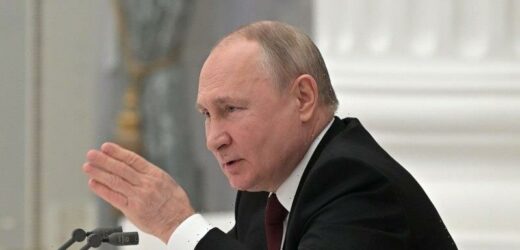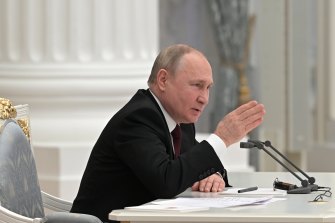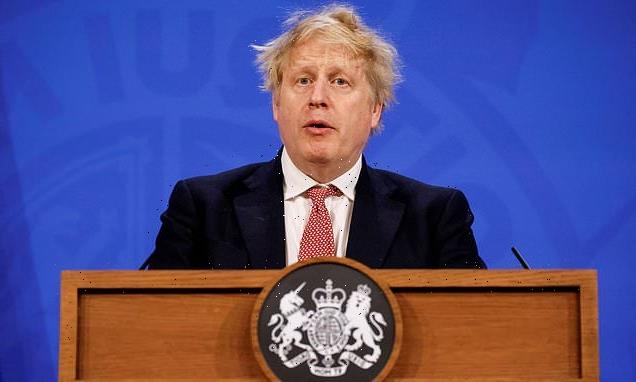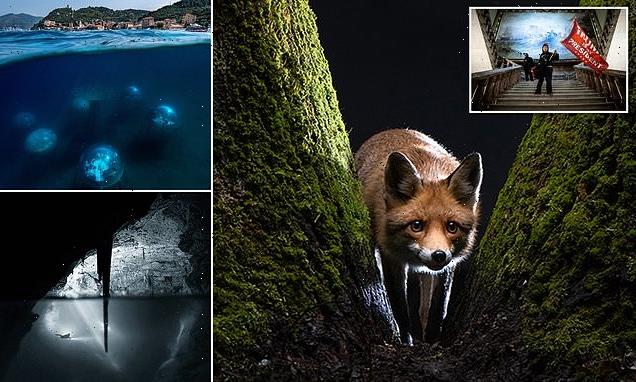A quick guide to the latest twists in the Ukraine crisis.
Russian president Vladimir Putin has ordered “peacekeeping” troops into eastern Ukraine, ratcheting up the prospect of war in Europe even higher despite weeks of feverish diplomacy.
On Tuesday morning AEST, as diplomats scrambled to arrange a last-minute peace summit between Russia and the United States, Putin officially recognised the independence of the two Russian-backed breakaway regions in the east of Ukraine that have been at the centre of a long-running standoff with Ukrainian soldiers, and sent his own troops in on “peacekeeping missions” to the rebel republics in Donetsk and Luhansk.
The move has been slammed by Western leaders as a violation of international lawand the United States, as well as Britain and the European Union, are looking to sanction the rebel-held areas – with stronger sanctions against Russia still on the cards if it invades. But in a fiery speech overnight, Putin railed against threats to Russian security by the expansion of Western military alliance NATO and said he was confident that Russian citizens supported his decision, repeating his claims that Ukraine should be part of Russia.
Russian President Vladimir Putin in Moscow on February 21. Credit:AP
Is this an invasion? What are the territories?
It’s not yet clear whether Russian forces will remain only in territory controlled by separatists, who have invited them, or whether they will push deeper into Ukraine, kicking off the invasion US intelligence warns is imminent. Ukraine and the wider world still view the separatist territory as Ukrainian, after rebels seized parts of Donetsk and Luhansk in the wider eastern Donbass region in 2014. Shortly before, Russia had seized on the ousting of Ukraine’s then pro-Kremlin president (during the Maidan revolution) to annex Ukraine’s Crimean Peninsula.
The Kremlin has long backed separatists in Donbass. (The eight-year conflict has claimed more than 14,000 lives, including 298 passengers on commercial flight MH17, shot down in 2014.) But its decision to now formally recognise the rebel regions narrows the diplomatic options to avoid war – it is an explicit rejection of the shaky ceasefire mediated by France and Germany in 2015, which was still touted by some diplomats as a framework for current negotiations despite escalating violations in recent days.
What are the signs of war?
The US says its intelligence shows Russian forces at the Ukrainian border have swelled to between 160,000 and 190,000, and are planning to attack the capital of Kyiv. Moscow has warships in the Black Sea and has been running military drills with neighbour and close ally Belarus. The New York Times reports that military vehicles and soldiers without insignia have been seen parked on highways near Rostov-on-Don, a large Russian city about 100 kilometres from the border with Ukraine. And several cyber attacks on the Ukrainian government have been blamed on Moscow.
Western countries fear a conflict on a scale unseen in Europe at least since the Yugoslav and Chechen wars of the 1990s, which killed hundreds of thousands of people and forced millions to flee. UK Prime Minister Boris Johnson says all the evidence suggests that Russia is planning “the biggest war in Europe since 1945”, positioning not just soldiers but blood supplies and other essential equipment beyond that used in training drills.
Last week, Russia claimed it was pulling troops back from the border, after repeated official denials that it plans to invade. But by Thursday, Russian-backed separatists were shelling the Ukrainian side, including a kindergarten. In a pre-recorded video message, they claimed Ukraine was planning an imminent attack on civilians, which Ukraine denied. Thousands of people were put onto buses for evacuation to Russia, as several explosions rocked the city of Donetsk, though there were no reports of injuries or independent confirmation of the circumstances.
Experts say the escalation of violence in the east is exactly the kind of “false flag” Russian sabotage operations that the West has been warning would be used by Moscow to sow violence in the region and create a pretext for war. Putin has already made false claims that Ukraine is carrying out a “genocide” against Russian speakers in the east, many of whom Russia has now issued passports to, and the Russian authorities have announced an investigation into supposed “mass graves” of the victims of Ukrainian forces.
In 2014, when Putin sent his “little green men” – soldiers without Russian insignia – into Ukraine to seize Crimea, they also did so under the pretence of defending Russian speakers against a revolution they labelled a “facist coup”. When it sent troops into Georgia in 2008, waves of cyber attacks and disinformation also hit first.
Russia has agreed to more peace talks with the West later this week, which the US has previously said will go ahead only if Russia does not invade.
Prime Minister Scott Morrison has also rubbished suggestions Russia is sending in “peacekeeping” troops to eastern Ukraine, saying Moscow has “moved in on Ukrainian sovereign territory”.
What does Putin want?
With Russia at its back, a clutch of NATO countries to the west and the Black Sea on its doorstep, Ukraine has become the epicentre of the Kremlin’s fight to keep control of eastern Europe. Ukraine has close ties to Russia, but has been an independent nation since the Soviet Union collapsed in 1991. It wants to join a growing list of countries in the region becoming part of the NATO alliance.
But Putin still sees Ukraine as part of Russia and experts say he wants to restore some of the glory of the Soviet era, extending his “sphere of influence” in Eastern Europe to keep a buffer between Russia and the West. He questions why NATO, which formed after World War II to safeguard peace in Europe (and contain the Soviet Union), has continued to expand since the Soviet Union broke apart. And he doesn’t just want NATO to disavow talk of Ukraine ever joining its alliance, he wants them to pull back their forces from Eastern Europe too, effectively rewriting the old boundaries agreed in 1997.
Until those demands are met, Russia has so far said it will not deal with the US on other issues both sides have said they are willing to negotiate on, such as greater restrictions on nuclear weapons in the region.
In his furious speech on Tuesday, Putin blamed NATO for turning Ukraine into a theatre of war and called the US-led alliance an existential threat to Russia.
What about Ukraine?
Shortly after Putin’s speech, Ukrainian President Volodymyr Zelensky accused Russia of wrecking peace talks and ruled out making any territorial concessions, though he stressed Ukraine was still committed to diplomacy. Ukraine is expecting “clear and effective” steps from its allies to act against Russia, he said. He has called for immediate sanctions by the West and an emergency summit of the leaders of Ukraine, Russia, Germany and France.
“We are not afraid, we won’t cede anything,” Zelensky said.
Ukraine’s civilian militias have swelled in recent weeks and Western countries such as the US and the UK have been sending in weapons as part of a “porcupine” strategy to make Ukraine so spiky with threats it could become too difficult for the larger Russia to swallow.
If you'd like some expert background on an issue or a news event, drop us a line at [email protected] or [email protected]. Read more explainers here.
Most Viewed in World
Source: Read Full Article



